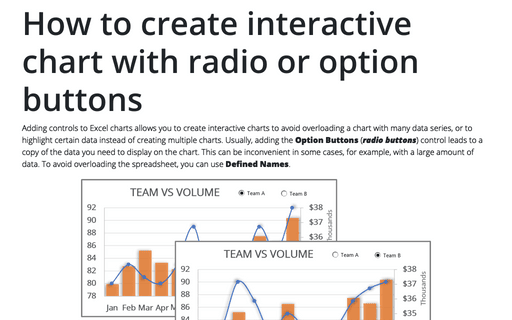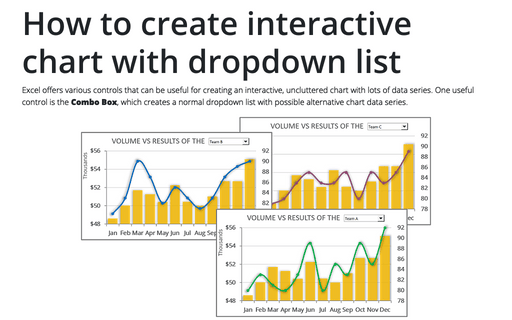How to create interactive chart with radio or option buttons
See other techniques for creating interactive charts.

Option buttons (also known as radio buttons) are used to select from a list of options.
The trick to using Option buttons is to assign the same cell to all the Option buttons in a particular group. Initially, the cell value is assigned to the first element of the option group. Next, all added Option buttons will automatically use and change the value of this cell.
To create an interactive chart with option buttons, do the following:
1. Prepare the data that will be shown in the chart
Add additional data to your spreadsheet for option button values:
For example, enter in the cell G2 the number 1:

2. Define names
Create data ranges, which will be used for the interactive chart:
2.1. On the Formulas tab, in the Defined Names group, click Define Name (see Creating and using named ranges for more details):

2.2. In the New Name dialog box, define the name of the data series to display:
- In the Name field, enter the name of this new range, for example, Name,
- In the Refers to field, enter this formula:
= CHOOSE (<index>, <first item>, <second item> ...)
The CHOOSE () function returns the value from the list (<first item>, <second item>, etc.) specified by the first parameter <index>.
In this example:
= CHOOSE ($G$2, $C$2, $D$2):

2.3. Add the new data range to define the data series values to display:
- In the Name field, enter the name of this new range, for example, Team,
- In the Refers to field, enter this formula:
= INDEX (<table>, 0, MATCH (<name>, <headers>, 0))
The MATCH () function searches the specified element <name> in a range of data <headers> and then returns the relative position of that element in the range.
The INDEX () function returns the value of an element in a table or an array from the range of data specified by the parameter <table>, selected by the row (second parameter, 0) and column number (third parameter).
In this example:
= INDEX ($C$3:$D$14, 0, MATCH (Name, $C$2:$D$2, 0)):

3. Create a chart with visible data
Create a chart for any of the columns (in this example, the first column for Team A):

4. Change the data series
4.1. Do one of the following:
- On the Chart Design tab, in the Data group, choose Select Data:

- Right-click on the chart area and choose Select Data... in the popup menu:
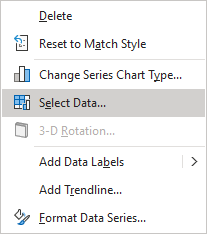
4.2. On the Select Data Source dialog box, for the Legend Entries (Series), click the Edit button:

4.3. In the Edit Series dialog box, change Series name and Series Y values (or Series values) to the appropriate names of the created ranges:

5. Add the option buttons to the chart
5.1. On the Developer tab (see Show the Developer tab), in the Controls group, click the Insert drop-down list and then choose Option Button (Form Controls):

Note: You can also add to the Quick Access Toolbar (see how to add commands to the Quick Access Toolbar):
- The entire Insert controls dropdown list:
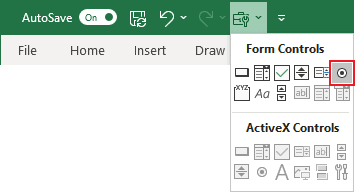
- The Option Button control.
Add as many option buttons as the number of series can be selected by these option buttons and place them where you want.
In this example, just two option buttons were used:

5.2. Format option buttons:
5.2.1. Double-click on every option button and change the label.
5.2.2. Right-click on each options button and choose Format Control... in the popup menu:
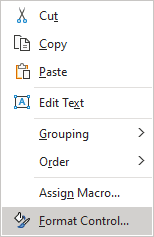
5.2.3. In the Format Control dialog box, on the Control tab, choose the appropriate cell in the Cell link field (in this example, G2):

See also this tip in French: Comment créer un graphique interactif avec des boutons radio ou des cases d'option.
